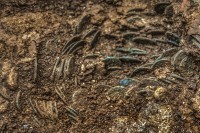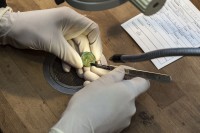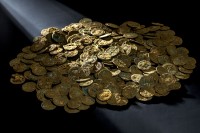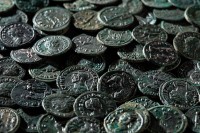 Farmer Alfred Loosli was walking through in his cherry orchard in Ueken in the northern Swiss canton of Aargau last year when he saw a green coin contrasted against the rich brown of the soil. At first the he assumed someone had lost it, but then he found another five. This July, Loosli poked a molehill under one of his cherry trees and found another 19 bronze coins. He asked his son to research the coins to see if they might be ancient, remembering that in 2013 a Roman settlement was discovered in the nearby city of Frick.
Farmer Alfred Loosli was walking through in his cherry orchard in Ueken in the northern Swiss canton of Aargau last year when he saw a green coin contrasted against the rich brown of the soil. At first the he assumed someone had lost it, but then he found another five. This July, Loosli poked a molehill under one of his cherry trees and found another 19 bronze coins. He asked his son to research the coins to see if they might be ancient, remembering that in 2013 a Roman settlement was discovered in the nearby city of Frick.
They called the authorities and in September canton archaeologists began to excavate the site. The excavation was kept secret to keep looters from interfering with the site when the archaeologists weren’t around, and it was productive beyond all expectations. By the end of the dig earlier this month, archaeologists had recovered 4155 Roman coins for a total weight of 33 pounds in just a few square meters. At least some of the coins were buried in cloth and leather bags and probably they all were only the bags have disintegrated.
 The hoard in now at the Vindonissa Museum in Brugg where conservators are painstakingly cleaning the coins. Swiss numismatist Hugo Doppler has examined the 200 coins cleaned thus far and has identified them as Antoniniani minted by emperors Aurelian (270-275), Tacitus (275-276), Probus (276-282), Carinus (283-285) Diocletian (284-305) Maximianus (286-305). The most recent were minted in 294 A.D. They are in exceptional condition. Hopper believes they were taken out of circulation almost immediately after minting.
The hoard in now at the Vindonissa Museum in Brugg where conservators are painstakingly cleaning the coins. Swiss numismatist Hugo Doppler has examined the 200 coins cleaned thus far and has identified them as Antoniniani minted by emperors Aurelian (270-275), Tacitus (275-276), Probus (276-282), Carinus (283-285) Diocletian (284-305) Maximianus (286-305). The most recent were minted in 294 A.D. They are in exceptional condition. Hopper believes they were taken out of circulation almost immediately after minting.
The Antoninianius coin is named after the emperor Caracalla (Marcus Aurelius Severus Antoninus Augustus) who first introduced the denomination in 215 A.D. as a silver piece worth two denarii, but because it only contained 1.5 denarii worth of silver, people raised prices and hoarded the coins causing rampant inflation. The Antoninianius became increasingly debased until by the reign of Emperor Gallienus in 268, the silver content was a meager 4%. Aurelian bumped it back up to 5%, but even that small boost was short-lived. At the end of the 3rd century, the Antoninianius was almost entirely bronze and considered worthless. People just threw them away.
 The 200 coins from the cherry orchard hoard, however, are all of particularly high silver content, about 5% silver. Hugo Doppler believes the owner of the hoard deliberately chose the coins with the highest silver content because they “would have guaranteed a certain value conservation in a time of economic uncertainty.” In a rural area like Ueken, there would have been no banks to put valuables in, and the area was subject to several Germanic incursions. Burying bags of relatively high silver content coins underground was a reliable method of keeping the treasure safe.
The 200 coins from the cherry orchard hoard, however, are all of particularly high silver content, about 5% silver. Hugo Doppler believes the owner of the hoard deliberately chose the coins with the highest silver content because they “would have guaranteed a certain value conservation in a time of economic uncertainty.” In a rural area like Ueken, there would have been no banks to put valuables in, and the area was subject to several Germanic incursions. Burying bags of relatively high silver content coins underground was a reliable method of keeping the treasure safe.
Significant hoards like these have been unearthed many times in Britain, but are much rarer in Switzerland. Only four Roman coin hoards of more than 4,000 pieces have been found in Switzerland. Two were discovered a century ago; the third was found last year in Orselina, 150 miles south of Ueken near the Italian border.
 The hoard will continue to be cleaned and examined. Doppler suspects there may be more exciting discoveries among the coins, like previously unknown mints and denominations. The hoard will eventually be put on public display at the Vindonissa Museum alongside other Roman artifacts discovered at the Frick excavation and elsewhere in the area.
The hoard will continue to be cleaned and examined. Doppler suspects there may be more exciting discoveries among the coins, like previously unknown mints and denominations. The hoard will eventually be put on public display at the Vindonissa Museum alongside other Roman artifacts discovered at the Frick excavation and elsewhere in the area.
Love reading about coin hoards
Me too, especially in unusual places.
“In a rural area like Ueken, there would have been no banks to put valuables in…”
Did the Romans have banks? Never occurred to me that they might have…I assumed they all kept their wealth buried somewhere…
They did indeed. Argentarii had storefronts usually in the forum area. They kept people’s money and paid out when authorized via a bank draft (very helpful when all currency is in coin; think of how incredibly hard to transport the sheer weight of a large transaction would be), or kept it in an interest-bearing account on condition that the argentarius could use the money to make more money, and lent money at interest. The same financial crises of the 3rd century that were both symptom and cause of inflation also resulted in rampant bank failures, so even if our Ueken fellow had access to a bank, he could well have thought a hole in the ground a much safer bet, and he wouldn’t have been wrong.
How would we know how many hoards have been found in Switzerland? Surely we know only how many have been reported?
True, we only know how many have been reported.
Hoards allover. Looks indeed as if somebody had closed his account. :confused:
There was only cheese with holes in it in that one anyway. :giggle:
I’m curious how the typical Empire-dweller at the time would learn what percentage of silver was in a given coin. Was it just general knowledge that filtered out to the populace from the mints, or was there a simple test one could apply to a coin to determine its likely value?
That is an excellent question. My guess would be the touchstone method since it was widely practiced in antiquity and wouldn’t damage the coin, but I doubt a regular guy on the street would have the knowledge and materials to do that. Perhaps the hoarder worked in a mine or in some other metallurgic profession.
sad to think the owner never made it back for his hoard. probably killed in a raid or sold into slavery among the barbarian tribes. how awful to have lived In those times. we find these hoards only guessing the human tragedy that befell the family.
or the old man died before he could tell his family were buried them. imagine seven sons and daughters digging up every mole hill on the family property where in the hell did dad bury those coins!!
If the owner did meet a horrific fate, it’s very likely any family he had in the area joined him in it. On the other hand, he may have been passing through or may have not owned the land where the orchard now stands. There are so many variables. I find it fascinating to explore them all. It’s like a choose your own adventure novel built around real history.
I can only imagine how many other hoards may (or may not) exist locally. Reminds me of the Sutton Hoo find in England. Good writing.
If one had a decent scale and a weight that matched what a denari would weigh (possibly a denari known to have the correct amount of silver), one could compare weights, since the adulterating base metals would be lighter, and percentages of metals are based on weight. I grew up in a gold mining/prospecting area that had gold in all its forms on its collective mind, and the weight test was usually the first test the assay office used. Before it became a metaphor, a touchstone was a piece of dark stone that left a dark streak on soft metals like gold and silver, but would not have determined the percentage. Modern chemical tests can do that with some accuracy, and are commonly used to day. I’d think that at the time this hoard was stashed, the weight method would have been the method used. Folks collecting that much gold (and in mint condition) may well have had access and knowledge of scales and weights.